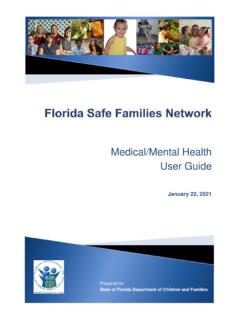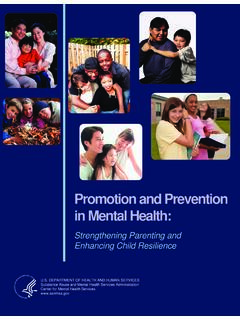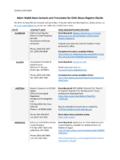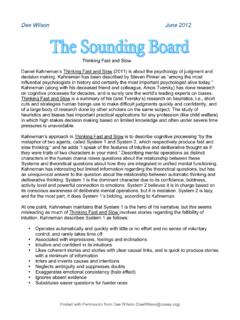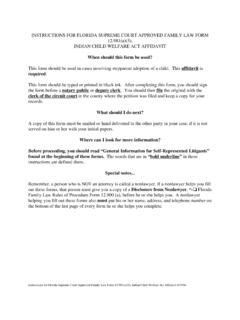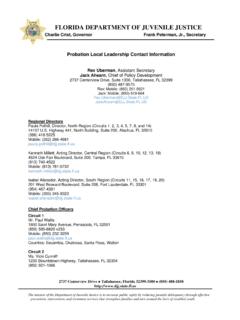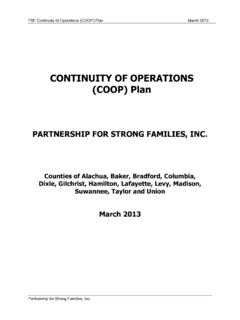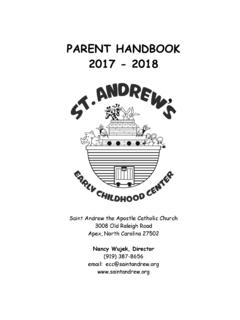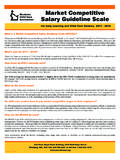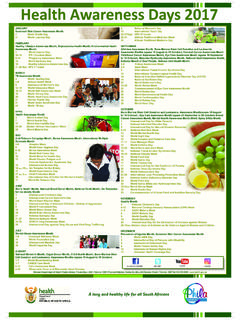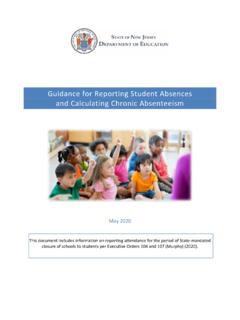Transcription of March 24, 2017 CFOP 170-7 - Florida's Center for …
1 March 24, 2017 cfop 170-7 TABLE OF CONTENTS Paragraph ii Chapter 1 GENERAL REQUIREMENTS Purpose .. 1-1 Authority .. 1-2 Non-Negotiables .. 1-3 Identification and Selection of Least Intrusive Actions .. 1-4 Family Input .. 1-5 Removing Children from Parent(s)/Legal Guardian(s) .. 1-6 Judicial Actions Related to child safety .. 1-7 Staffings with Children s Legal Services (CLS) .. 1-8 Scope and Dependability of safety Plans .. 1-9 FSFN Documentation .. 1-10 Chapter 2 DEVELOP PRESENT DANGER safety PLAN Definition of Present Danger Plan .. 2-1 During an Investigation .. 2-2 During On-going Case Management .. 2-3 Supervisor Consultation and Approval .. 2-4 FSFN Documentation .. 2-5 Chapter 3 DEVELOP IMPENDING DANGER safety PLAN Definition of Impending Danger Plan .. 3-1 Required In-Home safety Analysis .. 3-2 safety Management Conference .. 3-3 Related safety Plan Responsibilities .. 3-4 Supervisor Consultations and Approval .. 3-5 FSFN Documentation.
2 3-6 Chapter 4 safety PLANS WHEN THERE IS INTIMATE PARTNER VIOLENCE Purpose .. 4-1 child safety Planning with Confidential safety Actions.. 4-2 Injunctions .. 4-3 Supervisor Consultation .. 4-4 FSFN Documentation .. 4-5 Chapter 5 safety PLAN INVOLVING RELEASE OF A child WITH NON-MALTREATING PARENT/LEGAL GUARDIAN Purpose .. 5-1 When Other Parent Home Assessment Is Required .. 5-2 Required Background Check .. 5-3 Interviews and Information Gathering .. 5-4 Completing the OPHA after child Placement with Another Caregiver .. 5-5 On-Going Assessment .. 5-6 Supervisor Consultation and Approval .. 5-7 FSFN Documentation .. 5-8 Chapter 6 safety PLAN INVOLVING A FAMILY-MADE ARRANGEMENT Purpose .. 6-1 Requirements .. 6-2 Assessment Process .. 6-3 On-Going Assessment of Sufficiency of a Family-Made Arrangement .. 6-4 Closing Cases with a Family-Made Arrangement .. 6-5 Supervisor Consultation and Approval .. 6-6 FSFN Documentation .. 6-7 March 24, 2017 cfop 170-7 TABLE OF CONTENTS (continued) Paragraph iii Chapter 7 APPROVAL OF INFORMAL PROVIDERS IN safety PLANS Purpose.
3 7-1 Interview with Informal Provider .. 7-2 Background Screening .. 7-3 Supervisor Consultation .. 7-4 FSFN Documentation .. 7-5 Chapter 8 safety MANAGEMENT SERVICES Purpose .. 8-1 safety Management Service Categories and Types .. 8-2 Chapter 9 ESTABLISH CONDITIONS FOR RETURN Purpose .. 9-1 When Conditions for Return Are Required .. 9-2 Supervisor Consultation and Approval .. 9-3 FSFN Documentation .. 9-4 Chapter 10 ESTABLISH FAMILY TIME/VISITATION PLAN Purpose .. 10-1 safety During Visitation .. 10-2 Court Orders .. 10-3 Observations of Visits .. 10-4 FSFN Documentation .. 10-5 Chapter 11 MANAGE safety PLANS Purpose .. 11-1 child , Parent/Legal Guardian and Caregiver Contact Requirements .. 11-2 Communication with safety Service Providers .. 11-3 Modifications to safety Plans .. 11-4 Supervisor Consultation and Approval .. 11-5 FSFN Documentation .. 11-6 Chapter 12 IMPLEMENT REUNIFICATION AND POST-PLACEMENT SUPERVISION Purpose.
4 12-1 Due Diligence to Achieve Reunification .. 12-2 Planning Conference Associated with Reunification .. 12-3 Implementation of Reunification .. 12-4 Post-Placement Supervision .. 12-5 Supervisor Consultation and Approval .. 12-6 FSFN Documentation .. 12-7 Chapter 13 DISCONTINUE A safety PLAN Purpose .. 13-1 Actions To Discontinue a safety Plan .. 13-2 Discontinuing a safety Plan for Children Placed Out-of-State .. 13-3 Discontinuing a safety Plan for Family Unable to Locate .. 13-4 Family with Unsafe child (ren) Refuses to Participate in safety and Case Planning .. 13-5 Court Orders Case Closed Involving Unsafe child .. 13-6 Supervisor Consultation and Approval .. 13-7 FSFN Documentation .. 13-8 March 24, 2017 cfop 170-7 TABLE OF CONTENTS (continued) Paragraph iv Appendix A: safety Planning Analysis Appendix B: safety Management Provider Can and Will Protect the child Appendix C: Conditions for Return March 24, 2017 cfop 170-7 1-1 Chapter 1 GENERAL REQUIREMENTS 1-1.
5 Purpose. A safety plan controls and manages danger threats to a child when a parent/legal guardian is unavailable, unable, or unwilling to protect his or her child . The child welfare professional responsible for the case has primary responsibility for developing and managing the safety plan. A safety plan will be established in response to present or impending danger that meets threshold criteria in cfop 170-1, Chapter 2, paragraph 2-2, Present Danger, and paragraph 2-8, Impending Danger. A safety plan addresses a specific parent behavior, emotion or condition that results in a child being unsafe. A safety plan must use the least intrusive means appropriate to manage the danger. A safety plan will be in effect as long as a case remains open and parent(s) /legal guardian(s) do not have sufficient protective capacity to protect the child from out of control conditions in the home that would otherwise qualify as danger threats. 1-2. Authority. The following provide the legal authority for the establishment of safety plans in response to present or impending danger.
6 A. Section (9)(a)(6), Florida Statutes ( ). b. (3), Florida Administrative Code ( ), safety Planning Requirements. c. , , safety Planning and Case Transfer. d. , , Case Management Responsibilities After Case Transfer. e. , , Least Intrusive Interventions. f. , , Judicial Reviews and Court Reports. g. , , Post-Placement Supervision and Services. h. , , Termination of Services. 1-3. Non-Negotiables. The need for the establishment of a safety plan is non-negotiable with the family when present danger ( cfop 170-1, Chapter 2, paragraph 2-2) or impending danger is identified ( cfop 170-1, Chapter 2, paragraph 2-8). A determination of impending danger also requires a case plan. The child welfare professionals responsible for the investigation and subsequent case management must explain to the parent(s)/legal guardian(s) how their action, choice, or arrangement compromises the child s safety . a. The child welfare professional will also determine if there are any non-negotiable conditions of the safety plan.
7 To the degree possible, non-negotiables must only reflect essential safety actions needed to keep the child (ren) safe. b. safety actions that are non-negotiable include, but are not limited to, the following: (1) Supervision in the home at times when the parent(s)/legal guardian(s)' behavior is known to be out of control. (2) The behavior of one parent/legal guardian is so out of control and unpredictable that they must not be in the home. The parent/legal guardian should still be encouraged to assist in developing a child visitation plan. When there is intimate partner violence, feedback from each parent March 24, 2017 cfop 170-7 1-2 as to child visitation will be gathered and used to develop a visitation plan as described in Chapter 4 of this operating procedure. (3) The behavior of both parent(s)/legal guardian(s) is so out of control that conditions in the home are unpredictable and preclude an in-home safety plan. The child welfare professional should ask the parent(s)/legal guardian(s) for their placement preferences.
8 (4) In a court-supervised case, child (ren) aged 0 to 6 years and already enrolled in a licensed childcare setting must continue enrollment and attendance five days a week (s. , ). Depending on local resources, the child welfare professional may offer licensed childcare program choices. The court has the discretion to rule otherwise. The child welfare professional responsible must notify the operators of the childcare program that the child is in a safety plan and expectations for contacting the child welfare professional responsible if the child has unexcused absences. 1-4. Identification and Selection of Least Intrusive safety Actions. a. Depending upon how the danger threat is manifesting in the home, the child welfare professional will choose the least-intrusive safety actions necessary to protect the child . Least instrusive is defined in cfop 170-1, Chapter 2, paragraph 2-6. b. Two safety plans will be created and active at the same time for either of the following situations: (1) There is intimate partner violence and certain information must be kept confidential from the perpetrator per requirements in Chapter 4 of this operating procedure.
9 (2) As a result of a timesharing custody agreement, the child is residing in two households where safety actions are necessary. c. The child welfare professional has the following possible safety actions to consider: (1) safety actions that involve the use of an In-Home safety Plan in order of least intrusive to most intrusive are as follows: (a) Responsible adult routinely monitors the home at the times when danger manifests. (b) When less than full-time supervision is necessary, a responsible adult moves into the home. (c) Alleged perpetrator temporarily leaves the home. (d) The non-maltreating parent/legal guardian temporarily leaves the home with the child . (2) safety actions that involve the use of an Out-of-Home safety Plan are as follows: (a) Release of child to another parent/legal guardian after approval of an Other Parent Home Assessment is generally the preferred placement. There will be situations when the child does not have a relationship established with the other parent/legal guardian and it is determined that there will be less trauma for the child to be placed with someone in the family network that they know and with whom they are comfortable.
10 In such situations, the child welfare professional must still ask the non-removal parent/legal guardian if they agree with placement of the child with the relative/non-relative. March 24, 2017 cfop 170-7 1-3 (b) child temporarily resides with someone in the family network under an approved family-made arrangement when no restrictions on parental access are necessary. (c) child placed with a relative/non-relative. (d) child placed with the adoptive parent of the child s sibling after an approved relative/non-relative home study unless the home is a licensed foster care setting. (e) child placed in a licensed emergency shelter/foster care placement due to no appropriate relative/non-relative placement being known or available. (3) The child welfare professional has the following possible safety actions to consider: (a) Combine the use of in-home and out-of-home actions as appropriate. (b) Choose one or more safety management service providers that can best address the identified danger threat.

